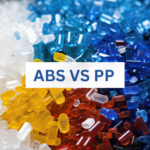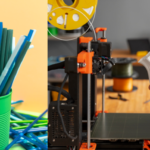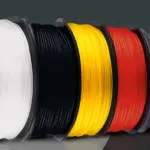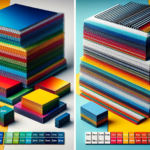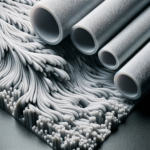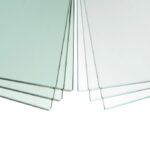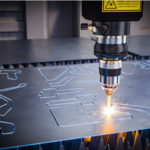Are you thinking of buying or learning about laser machines? Probably wondering which type of laser will be beneficial for you and your business. If you have stumbled between two main laser cutting: CO2 Laser Vs Fiber Laser cutting.
We can help you to solve this riddle of your mind!
During this article, we will talk about their techniques, types, thickness, benefits, and drawbacks, cost, materials they can cut, along with their comparison and things you should consider when deciding between CO2 laser and fibre laser cutting.
Table of Contents
CO2 Laser Cutting
The term “CO2 Laser” refers to the laser’s generation process rather than the light itself. The ions of light particles are split using some means (usually RF or DC excitation) in a resonator purged with CO2 gasses at high velocity (turbos or blowers), causing the light particles to collide with each other and split at even greater intervals.
CO2 cutting is ideal for fine details and acute angles, and it usually involves two axes and a moving table.
It’s a speedy procedure for materials less than 3/8 inches thick, but higher-powered machines can handle heavier metals swiftly as well.
Benefits of CO2 Laser Cutting
- A CO2 Laser can cost anywhere from $350,000 to more than $1 million to purchase, with optical mirrors and consumables making up the majority of the cost. After the initial investment, operating expenditures are roughly $20 per hour.
- CO2 Lasers generally produce sharp edge quality on stainless and aluminium surfaces.
- CO2 Lasers offer flexibility across a range of laser applications including non-metals.
- The CO2 laser was first introduced more than 50 years ago and is now the industry’s traditional pillar. Several features of the CO2 laser has resulted in its prolonged popularity for industrial welding and cutting.
Drawbacks of CO2 Laser Cutting
- CO2 Lasers consume a lot more power than Fiber Lasers. When operating at maximum power, high-power CO2 will require around 70 kW. A fibre laser of equivalent power requires around 18 kW.
- This technique requires mirrors, lenses bellows, and las gas system to keep the beam path delivery system pure and clean. And maintenance of the beam path delivery system is costly as well.
- A CO2 Laser cannot match the speed of fibre in thin materials. A 4KW CO2 in 16 GA Mild Steel using N2 as a cutting gas, has a recorded cutting speed of just 260 IPM, but an equivalent equipped Fiber Laser has a cutting speed of over 1,417 IPM
Fibre Laser Cutting
The fibre optic delivery method of transporting the intense and amplified light source to the cutting head of the laser machine is referred to as a Fiber Laser.
The fibre gets the light source from the laser cutting machine’s resonator and transfers it to the CNC-controlled cutting head.
Fibre lasers do their best with high-contrast markings such as metal heating, cutting, and engraving.
They have a very narrow focus diameter (resulting in a 100-fold increase in intensity over a CO2 system), making them excellent for permanent marking of serial numbers, barcodes, and data matrices on metals.
Benefits of Fiber Laser cutting
- Fibre Lasers are less expensive than CO2 lasers, with prices ranging from $200,000 to $600,000. It also has cheaper operating expenses roughly $4 per hour because the solid-state setup does not require the mirrors and other equipment that the CO2 version does.
- Maintenance and greatly reduced maintenance as there’s no need to maintain the beam path delivery system.
- There is absolutely no comparison between Fiber Lasers and CO2 Lasers in thin materials. Fibre has a speed that is double to triple that of other materials.
- A Fiber Laser’s power consumption is roughly 1/3rd that of a CO2 laser due to lower resonator power requirements and lower cooling requirements.
Drawbacks of Fiber Laser cutting
- More complex jobs may slow down cutting speed, and special precautions must be taken to avoid long-term eye damage.
- Fibre technology is catching up with CO2 laser cutting in terms of flexibility as the latter offers a wide range of materials to work with.
- Fibre Laser cutting technology has to reach the level of CO2 Laser cutting in terms of thicker materials especially Stainless steel and Aluminium.
What Materials Can CO2 Laser and Fiber Laser Cut?
The CO2 laser can operate with a wide range of materials. They are capable of working with metals as well as organic materials (non-metallic).
Organic materials include wood, acrylic, plastic, rubber, leather, and other similar materials. Fibre laser machines mostly work with metals.
CO2 laser machines can’t work with all kinds of metals though. Some metals are highly reflective by nature. The laser beam of a CO2 laser machine is of short wavelength and thus gets easily reflected by highly reflective metals.
Fibre laser machines produce lower beam frequency laser making it suitable to work with all kinds of metals but work poorly with organic/non-metallic materials.
Contrarily CO2 machines can work with organic materials such as wood or plastic.
If fibre lasers are used on wood, it can cause a fire. It has the potential to melt plastic if used on it.
Materials CO2 Laser cutters can cut:
- Wood
- Acrylic
- Brick
- Fabric
- Delrin
- Leather
- Marble and Tile
- Matte Board
- Melamine
- Paper
- Mylar
- Pressboard
- Rubber
- Fibreglass
- Painted Metals
- Plastic
- Cork
- Anodized Aluminium and many more…
Materials Fiber Laser can cut:
- Aluminium
- Tungsten
- Carbide
- Non-semiconductor ceramics
- Coated and Painted Metal
- Fibreglass
- Carbon fibre
- Nickel
- Polymers
- Rubber
- Gold and Silver
- Stainless Steel and many more…
CO2 Laser Vs Fiber Laser Cutting
CO2 cutting was first introduced to the metal fabrication business around 1980. The introduction of fibre laser cutting machines has been the largest game-changer though CO2 is still relevant in the market.
Fibre laser technology has truly pushed the bounds of laser cutting into a new era when compared to CO2 lasers.
- Fibre laser cutting requires little to no maintenance while CO2 cutting requires timely maintenance.
- Fibre laser reduces power consumption whereas CO2 needs more power.
- Fibre laser produces more focused beams on metals while CO2 laser has a short wavelength and less frequency.
- Fibre laser machine provides superior cutting accuracy and fine edges compared to CO2 laser.
- The fibre laser machine is best suited for sheet metals and CO2 is suitable for thick metals.
- Focused beams with a narrow focal length of the Fiber laser machine gives more power density than that of CO2 laser.
- Fibre laser offers a better cutting speed than CO2 laser.
Things to consider when buying laser machines
CO2 laser has been around for 50 years and is still relevant in the market while Fiber laser is gaining popularity as it omits drawbacks of CO2 technology with advancement of its techniques.
The key variables when deciding between a CO2 and fibre laser are:
- Material & thickness
- Precision
- Production rate
- Purchase budget
- Operating costs
Summary:
Despite the fact, CO2 Laser vs Fiber Laser cutting is a topic that is currently losing popularity in our industry.
Which laser machine are you going to buy? CO2 or fibre, which is better? It all depends on your business requirements.
CO2 Lasers are an older and possibly declining technology, they are still a great choice for cutting non-metals.
While fibre laser is also on the way if you’re going to be working with reflective metals.
CO2 laser cutting has a speed advantage i.e five times greater on thin materials (less than 8 mm).
Whereas fibre laser is a game-changer in terms of financial benefits with 50% reduced operating costs and larger outputs.
You’ll need a CO2 laser cutting machine if you’re going to be cutting or engraving organic or non-metallic materials.
If you’ll be working with thin metals for the majority of your production, then consider a fibre laser machine as a good investment.
We recommend always double and triple-check before purchasing a machine to ensure that it meets your business needs.
Comment below freely if this article helped you!
